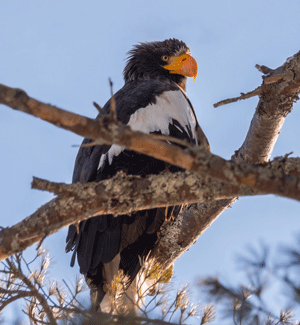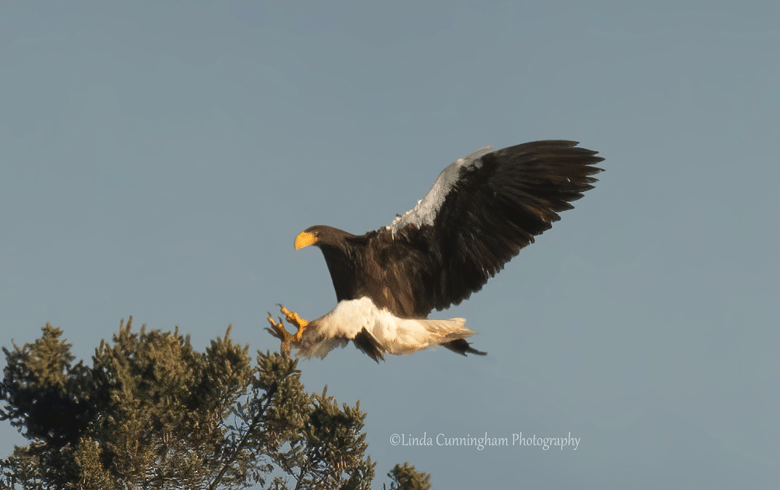A rare Asian eagle flew over the water pursued by a smaller local bird, a bald eagle, as more than a hundred people watched from the shore of Georgetown on New Year’s Eve. People had gathered at this precise spot in the hopes of seeing the rare bird, said to be in the area.
It was a Steller’s sea eagle, a 20-pound brown and white raptor with an eight-foot wingspan and a bright orange beak. The bird flew by to the delighted call of the crowd and the soft click of digital cameras.
“This is maybe the rarrest bird that’s ever been in Maine,” said Nick Lund of Maine Audubon. “This bird is on all levels just insane.” Not only is it impressive to see, he said, it also is rare anywhere. With an estimated 4,000 adults in the wild, the Steller’s sea eagle is listed as vulnerable by the International Union for Conservation of Nature.
The eagle continued to fly in the opposite direction from home, in a zigzagging course…
How this bird made its transcontinental flight from the Sea of Okhosk, off easternmost Russia and north of Japan, to the Gulf of Maine is an interesting tale. Over the past 15 months, the unmistakably large eagle has been reported in four U.S. states and three Canadian provinces. The eagle appeared to fly a meandering route starting in Alaska and coming to rest—at least for the time being—in Maine.

The story begins in icy northern Asia. The Steller’s sea eagle’s nesting grounds encircle the Sea of Okhotsk in the sub-arctic spruce-fir forests of northeastern Russia. Mating pairs build tree-top nests big enough to hold a king-sized bed, according to a National Geographic article from 1999.
While eagles are apex predators, their eggs and their newly hatched eaglets are vulnerable to enterprising predators including brown bears. A successful nest can produce one to three eaglets, who fledge in 90 days.
When nesting season is over, some Steller’s sea eagles winter along the coast or on rivers fed by hot springs. Others migrate as far south as Japan and Korea. Steller’s sea eagles are both predators and scavengers. Their preferred prey is salmon and cod, which they supplement with crabs, shellfish, squid, seabirds, small mammals, and carrion. On the coast they will scavenge beached whales and seals. Inland, they scavenge deer left by hunters.
When our wandering eagle first landed on the North American continent in August 2020, on the banks of the MacLaren River in Denali, it was only slightly off-course: just across the Bering Strait and over the Alaska Range. Still, it was a rare enough sighting for the Anchorage Daily News to report on the bird’s activities in a Sept. 5 column. It was caribou hunting season and the bird was seen near carcasses, “probably making a convenient meal from a hunter’s leftovers. What it was doing so far from its normal haunts is a mystery.”
The mystery was about to deepen.
The eagle continued to fly in the opposite direction from home, in a zigzagging course that is well-documented: Texas to Atlantic Canada, then Massachusetts and Maine. Everywhere the bird was reported, bird watchers mobilized to catch a glimpse of the rare visitor, and the media reported on it like a celebrity.
This is typical of wandering birds that are big and dynamic, said Lora Haller with U.S. Fisheries and Wildlife in Homer, Alaska. “Vagrants happen all the time in North America,” she said, though often it’s small birds that may not be recognized by the general public. “It’s pretty exciting when it’s a large bird like this. People notice.”
ALERT THE MEDIA
The Halifax Examiner called the eagle’s visit to Nova Scotia “about the coolest thing to happen around here lately.” The Bangor Daily News suggested in an editorial that although the Steller’s sea eagle had won hearts in Maine, it was “perhaps not a stellar navigator.” The New York Times was even more blunt when it declared the bird to be “very, very lost.”
Is it lost, though?
Rich MacDonald of the Natural History Center in Bar Harbor said in an interview that when birds wander far from their native range, “we don’t really fully know why. We have lots of theories.”
For a long time, bird experts believed that vagrancy was caused by a bird’s internal compass going awry. Now, MacDonald said, they are starting to recognize the reasons could be more complex than faulty navigation.
“Climate change is shifting where food is, and when it is,” MacDonald said. “Maybe the timing of food is shifting, changing migration patterns.” Vagrants could be an extreme example of birds looking for new places to go simply to get the food they need, he said.
“Maybe this is just a young pioneering bird,” MacDonald continued. “The bottom line is there’s no reason to think this bird won’t do just fine. Where’s it going to go, nobody knows.”





